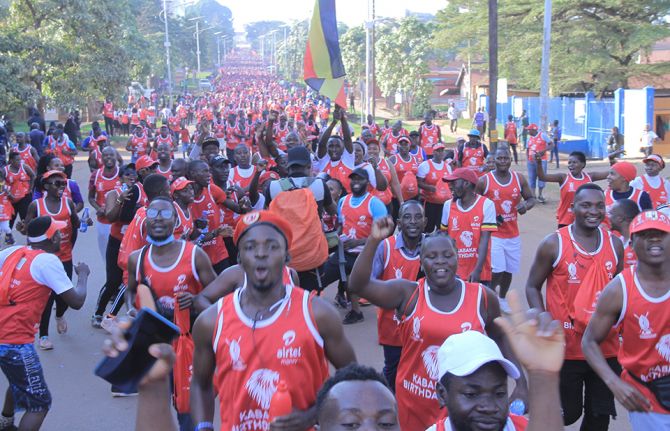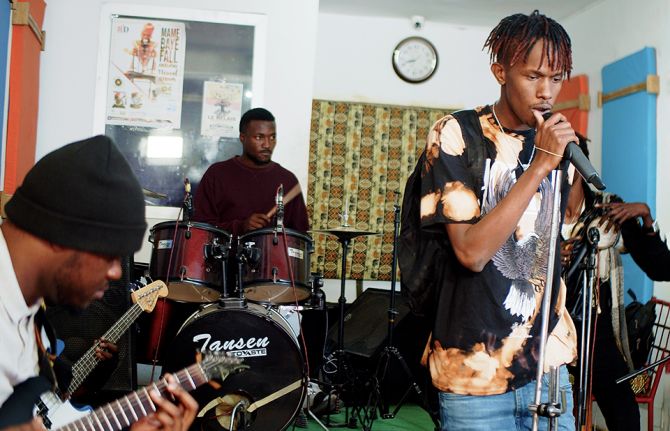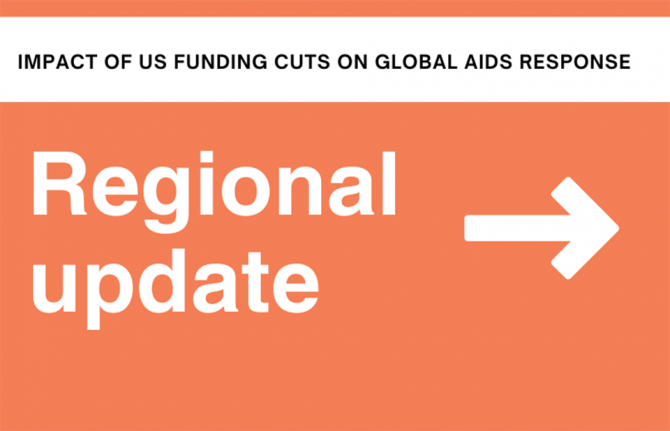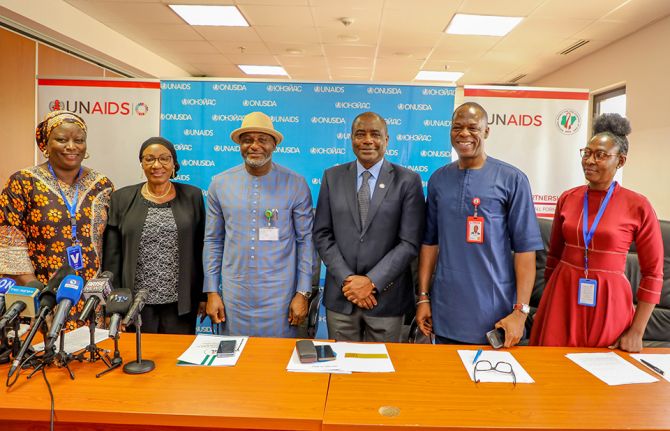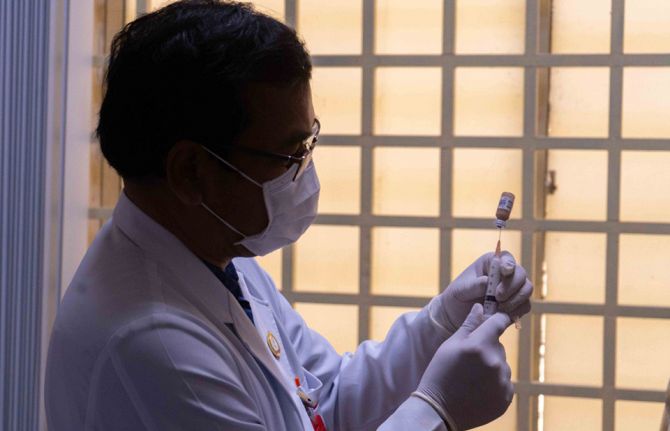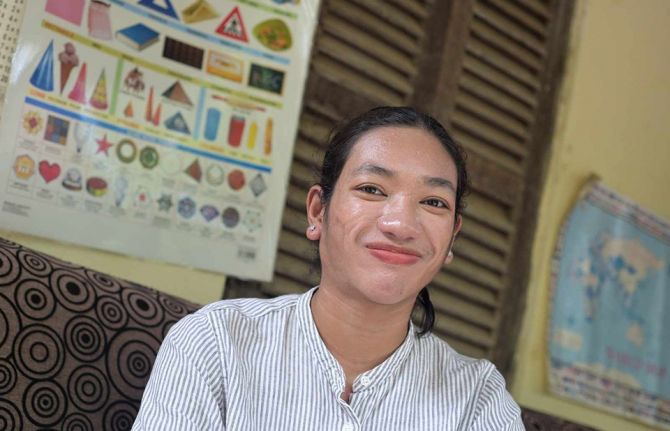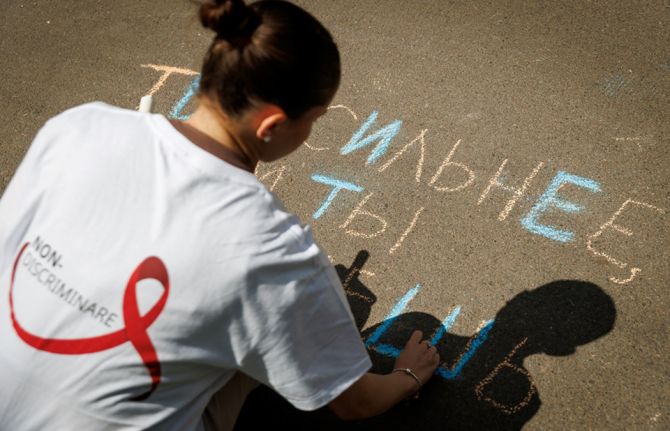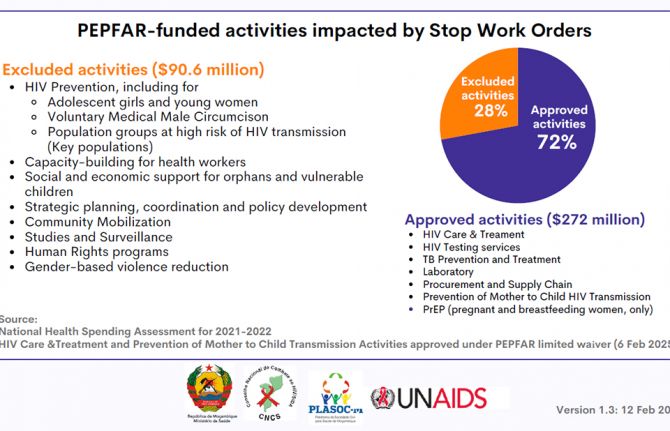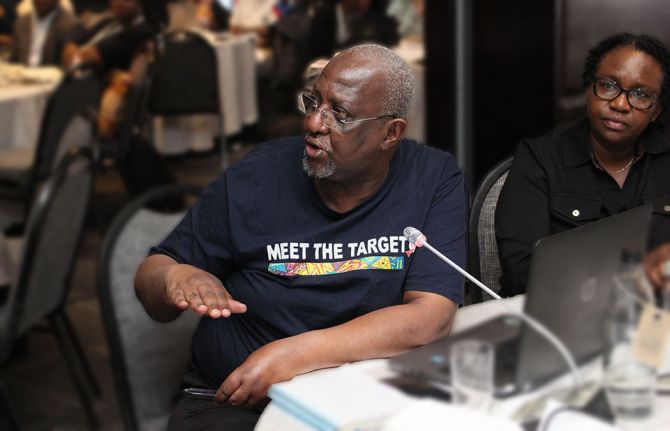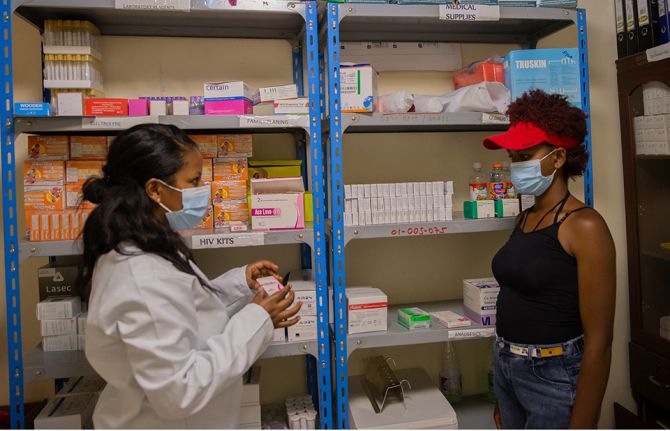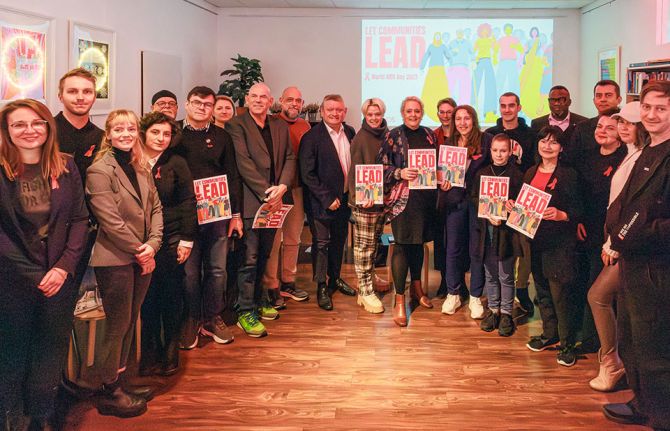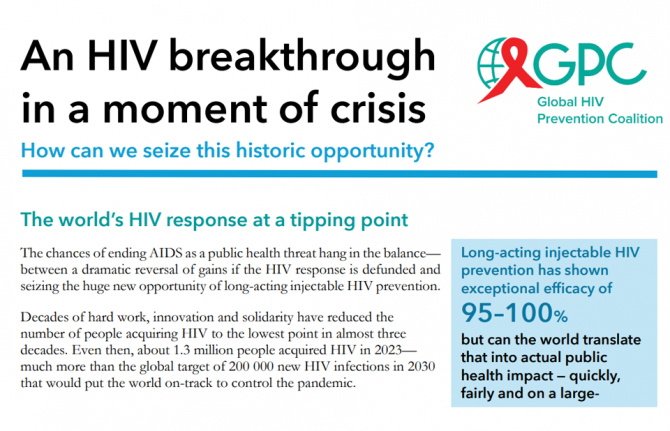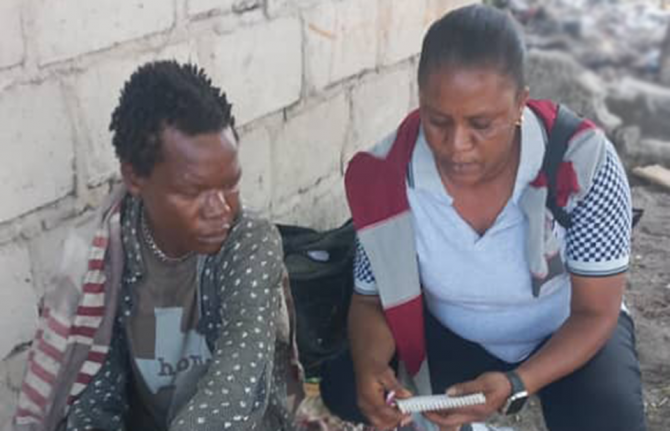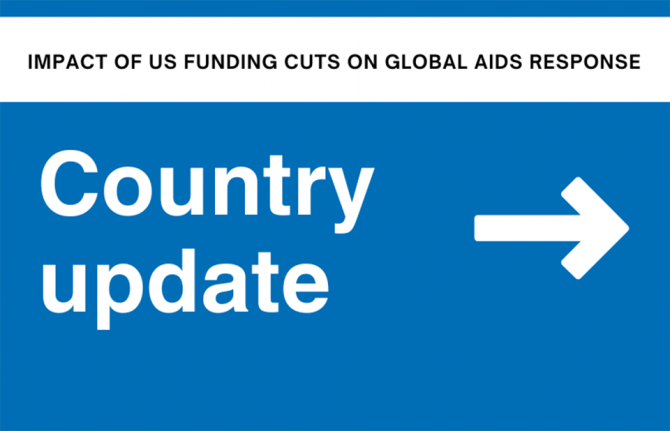
Feature Story
Millennium Development Goals and AIDS poster exhibition
23 September 2008
23 September 2008 23 September 2008
A poster exhibition on “Millennium
Development Goals and AIDS” is running
from 22 to 26 September in the Basement
Colonnade of the United Nations in
New York.
Marking the High-level Event on the Millennium Development Goals (MDGs) which takes place on 25 September, a poster exhibition on “Millennium Development Goals and AIDS” is running from 22 to 26 September in the Basement Colonnade of the United Nations in New York.
The exhibition explores the synergies between the AIDS response and the MDGs. Success will be mutual: the achievement of the MDGs will boost the AIDS response and conversely the response to AIDS can significantly contribute to several of the development goals.

Safeguarding women's rights and increasing
their economic independence reduces
their vulnerability to HIV.
Improving maternal health and reducing child mortality require strong health systems and an integrated HIV prevention, treatment, care and support services. Safeguarding women's rights and increasing their economic independence reduce the vulnerability of women to HIV. In addition universal access to HIV prevention, treatment, care and support is an important milestone for the achievement of the Millennium Development Goals.
The exhibition is an initiative of the Inter-Agency Working Group on AIDS, which includes UNAIDS Secretariat and Cosponsors as well as UNIFEM, the UN Dept of Public Info (DPI) and the UN Dept of Peacekeeping Operations (DPKO).
Millennium Development Goals and AIDS poster exhi
Feature stories:
Gaps remain in delivering on global commitments (10 September 2008)
External links:
United Nations web site on the Millennium Development Goals
Publications:
2008 Report on the global AIDS epidemic
Delivering on the Global Partnership for Achieving the Millennium Development Goals - MDG Gap Task Force Report 2008

Feature Story
The AIDS response: Relationship to development in Africa
22 September 2008
22 September 2008 22 September 2008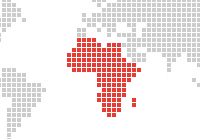
The AIDS response: Relationship to development in Africa
As high-level participants and international experts gather to discuss Africa’s development needs and challenges at UN headquarters in New York on 22 September, we take a look at how HIV and the AIDS response is impacting development on the continent.
In countries in Africa most heavily affected by HIV, the epidemic has reduced life expectancy by more than 20 years, slowed economic growth and deepened household poverty. However effective, sustainable AIDS responses offer an opportunity to overturn the critical development challenges to overcoming poverty, improving education, extending life expectancy and reducing child mortality.
Development needs leveraged through AIDS leadership
When committed national leadership on AIDS is combined with long-term coordinated financing, dividends beyond the epidemic are being seen in Africa. Scaling up HIV services means addressing years of under-investment in health human resources in resulting in strengthened health systems which lead to improved maternal and child health. As individuals benefit from antiretroviral treatment, they live longer and their labour productivity rises, lifting households from poverty and improving food security for their families.
“How we fare in fighting AIDS will impact all our efforts to cut poverty and improve nutrition, reduce child mortality and improve maternal health, curb the spread of malaria and tuberculosis.” - United Nations Secretary-General Ban Ki-Moon speaking at the General Assembly High Level Meeting on HIV/AIDS, New York, June 2008
In addition, an AIDS response that addresses deep seated drivers or causes of vulnerability to HIV infection—stigma, discrimination, gender inequality and human rights—will impact wider development.
Successes and progress
Affected countries in Africa are showing strengthening leadership in addressing challenges by increasing the use of their own resources. The per capita domestic public HIV expenditure (from governments’ own sources) in sub-Saharan Africa was six times greater than other parts of the world after adjusting by income level (2008 Report on the global AIDS epidemic).
The substantial increases in AIDS funding and the investment in prevention and treatment of recent years are producing encouraging results in a number of countries in Africa.
In Rwanda and Zimbabwe changes in sexual behaviour—waiting longer before becoming sexually active, having fewer multiple partners, increased condom usage among people with multiple partners—have been followed by declines in the number of new HIV infections. Condom use is increasing among young people with multiple partners in Benin, Burkina Faso, Cameroon, Chad, Ghana, Kenya, Malawi, Namibia, Uganda, Tanzania and Zambia.
HIV epidemics in Malawi, South Africa and Zambia appear to have stabilized and most of the comparatively smaller HIV epidemics in West Africa are stable or are declining, as is the case for Burkina Faso, Cote d’Ivoire, Mali and Nigeria. HIV prevalence in HIV epidemics in East Africa have either stabilized or are receding.
Gains in access to antiretroviral treatment
More people have access to HIV treatment than ever before. Of the 3 million people who received HIV treatment in 2007, more than 2 million of them are in sub-Saharan Africa. In the period 2003 to 2007, Namibia scaled up treatment from 1% to 88%, Rwanda from 3% to 71%. As a result we’ve seen number of AIDS-related deaths decline over the past two years from 2.2 million to 2 million in 2007.
This is paying incalculable dividends for African countries. HIV treatment means that HIV-positive people are living longer, in better health and with a higher quality of life. They can continue to be productive within their workplace and community and there is less risk of their household falling into poverty and food insecurity.
Good progress has also been made in the prevention of mother-to-child transmission of HIV with increases in coverage of services in countries including Botswana, Namibia, Swaziland and South Africa.
This progress suggests a return on the investments made on different fronts, particularly in HIV prevention and treatment, and shows that with continued commitment, countries can overcome the development challenge that the epidemic poses.
Demographic impact of HIV
However, in spite of successes the epidemic continues to outstrip the response. The 2008 report on the global AIDS epidemic released by UNAIDS shows that AIDS continues to be the leading cause of death on the continent of Africa. In southern Africa, the average life expectancy at birth is estimated to have declined to levels last seen in the 1950s—below 50 years for the sub-region as a whole.
The numbers are stark: 67% of all people living with HIV and almost 90% of children living with HIV are in sub-Saharan Africa. In Botswana and Zimbabwe more than one third of all deaths in children under 5 are due to AIDS.
Progress, but gaps remain
As pointed out in the UN Secretary-General’s Report to the June 2008 High-level meeting on AIDS, countries need to sustain the progress that they have already made and continued leadership is required for the implementation of fully funded and sustainable national strategies and programmes on HIV.
HIV: A public health and a development issue
HIV is both a public health and a development issue which requires a sustained, inclusive and multi-sectoral response.
The Commission on HIV/AIDS in Africa (CHGA) issued a report earlier this year which included a call for leadership at all levels to be mobilized and coordinated for a concrete HIV response and broader development plan. The report also calls for addressing gender inequalities in national strategies as 60% of people living with HIV in sub-Saharan Africa are women.
High-level meeting on Africa’s development needs
At the high-level meeting on Africa’s development needs taking place in New York on 22 September, heads of State or Government, ministers as well as civil society organizations, intergovernmental organizations, UN agencies, funds and programmes, as well as the Bretton Woods institutions will gather to discuss “Africa’s development needs: State of implementation of various commitments, challenges and the way forward.” The meeting will conclude with the adoption of a Political Declaration. UNAIDS Secretariat, its cosponsors and partners will host a series of side events.
The AIDS response: Relationship to development in
Publications:

Feature Story
Focus on China’s AIDS response
19 September 2008
19 September 2008 19 September 2008
With an estimated 700,000 people living
with HIV China’s HIV prevalence remains low
– estimated at less than 0.1 per cent of the
total population – but the epidemic
continues to grow in all parts of the country.
Credit: Creative Commons Attribution 2.0
License - Hao Wei
With an estimated 700,000 people living with HIV China’s HIV prevalence remains low – estimated at less than 0.1 per cent of the total population – but the epidemic continues to grow in all parts of the country. Most of the new HIV infections are related to sexual transmission and injecting drug use.
The AIDS epidemic remains a formidable challenge and several factors in China are fuelling it, including shame, fear, stigma and discrimination associated with AIDS, low awareness of HIV, rural poverty, high mobility of workers, availability and affordability of commercial sex, and injecting drug use.
There is no doubt that China has dramatically improved its AIDS response in recent years and its government has demonstrated real political leadership and commitment to effectively tackle the epidemic. This commitment has been translated into new laws, policies, growing HIV prevention efforts and increased access to treatment. The challenge for Chinese society now is to move from the excellent policies developed centrally to reach out to people in the provinces and communities with the services they need.
HIV prevention
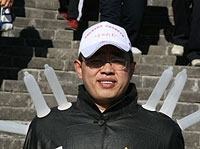
HIV prevention remains a top priority for
China’s AIDS response. More than 30 million
people are estimated to be practicing risky
sexual and drug use behaviour.
HIV prevention remains a top priority for China’s AIDS response. More than 30 million people are estimated to be practicing risky sexual and drug use behaviour. These include injecting drug users (IDUs), men who have sex with men, sex workers and their clients. For that reason, there has been an increase in programmes targeting those at higher risk, such as a methadone treatment for drug users, condom promotion among sex workers and clients as well as among men who have sex with men.
There have been improvements in HIV prevention programmes even though a full implementation of combination prevention is yet to be achieved. For example, methadone maintenance treatment, clean needles and syringe exchange for drug users has been introduced with the aim of establishing a total of 1500 methadone maintenance treatment clinics by the end of this year. These clinics represent an important milestone towards the implementation of a much needed comprehensive prevention approach for IDUs including needle exchange programmes and condom provision as well as treatment for sexually transmitted infections (STIs).
Treatment
HIV treatment, care and support has improved significantly over the last five years. Antiretroviral drugs are supplied to more than 34,600 individuals as part of the “Four Frees and One Care Policy”. This is a major improvement considering that in 2003 there were 5,000 people on treatment. The increased access to treatment has also contributed to the implementation of pilot studies for the introduction of second line antiretroviral (ARV) drugs at the national level, with particular attention to availability of these drugs and monitoring of adherence.
Stigma and discrimination
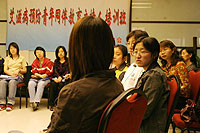
Stigma and discrimination continue to be
areas of concern both within the health care
setting and with the population at large.
Stigma and discrimination continue to be areas of concern both within the health care setting and with the population at large. A recent survey supported by UNAIDS and carried out in six major cities of China revealed that 41% would be unwilling to work in the same place with people living with HIV (PLHIV), 26% would not shake hands and 49% thought that they could get HIV through a mosquito bite.
In an attempt to address the situation, the banning of discrimination of people living with HIV has been outlined in the Law of Communicable Disease Prevention and Control and the 2006 Decree on AIDS.
Civil society
Civil society in China is still finding its feet. UNAIDS is investing significant resources in trying to bring together a diverse set of organizations and networks to get a stronger and more coherent contribution from civil society organizations as working with community groups can greatly increase the impact – and cost effectiveness – of AIDS strategies.
China has demonstrated a commendable leadership and commitment towards an effective AIDS response. The National five year plan to control AIDS (2006-2010) is currently being implemented and the coverage, quality and comprehensiveness of its implementation along with meaningful involvement of all stakeholders, will be the key to achieving the target of keeping HIV infected people below 1.5 million in 2010.
Focus on China’s AIDS response
Press centre:
Speech by Dr Peter Piot, UNAIDS Executive Director, Tsinghua University, Omnicom building. Beijing, 17 September 2008 (pdf, 1.85 Mb)
Feature stories:
UNAIDS recognizes leaders in China’s AIDS response (17 September 2008)
Related

Feature Story
UNAIDS recognizes leaders in China’s AIDS response
17 September 2008
17 September 2008 17 September 2008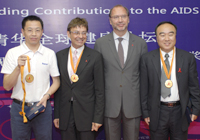
Three awardees of UNAIDS Award for Outstanding Contributions to the AIDS Response were presented by Dr Peter Piot (3rd from left). The three awardees are Prof. Li Xiguang (right), Executive Dean of Tsinghua University School of Journalism and Communication; Mr Serge Dumont (2nd left), UNAIDS Special Representative and Omnicon Group Inc. Senior Vice President and President Asia Pacific, and Yao Ming, Chinese Basketball icon (his manager on his behalf).
Progress in scaling up HIV prevention, treatment, care and support is underway in China thanks in part to the involvement of leaders from many different sectors of Chinese society in the AIDS response.
UNAIDS Executive Director Dr Peter Piot is acknowledging the contributions of nine such individuals during his official visit to China this week, 16-19 September, by presenting them with the UNAIDS’ “Award for Outstanding Contributions to the AIDS Response”.
Medals are awarded to Yao Ming, international Chinese basketball player, Serge Dumont, UNAIDS Special Representative and businessman, Li Xiguang, Executive Dean of Tsinghua University’s School of Journalism and Communication, Li Junru, Vice President of Central Party School, Doctor Xu Lianzhi from You’an Hospital, Doctors Ren Minghui, Hao Yang and Wu Zunyou with the Chinese Ministry of Health and Meng Lin, who is living with HIV and the head of the organization “Arc of Love”, which works for people living with HIV.
The awardees were chosen for their efforts to help stop the spread of HIV and to spur greater awareness of the epidemic in China, where an estimated 700,000 people are living with HIV in the country.
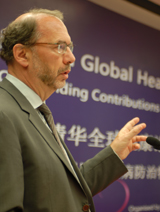
Dr Peter Piot, UNAIDS Executive Director, delivered an inauguration speech on Global and China’s AIDS epidemic and response at Global Health Forum in Tsinghua University, China.
Dr Piot is presenting the awards at several occasions throughout Beijing. The first ceremony was on 17 September at Tsinghua University, where he delivered the inaugural lecture for the university’s new Global Health Forum. Later the same day, Dr Piot presented the medal to Central Party School Vice President Li Junru following a lecture at the School on the role of leadership in China’s AIDS response.
Combating stigma in China, engaging more partners in the response
Yao Ming was recognized for his role in combating the stigma and discrimination faced by people living with HIV in China. A star player with the US National Basketball Association (NBA), Yao Ming has been a very important advocate for people living with HIV. In 2006, Yao featured in a PSA with HIV positive basketball icon Magic Johnson with key messages on stigma and discrimination. The PSA has been widely used in China and was used in the UNAIDS-International Olympic Committee (IOC) Olympic AIDS Campaign. Yao Ming also featured in the UNAIDS-IOC AIDS leaflet that accompanied all condoms distributed at the Beijing Olympics as part of that campaign.
“I am very honoured to receive this esteemed award for AIDS work,” said Yao Ming, who received his award by video. “Contributing to the fight against AIDS is something that I happily do as I believe that AIDS is one of the most important global problems. We can and we should all do something to stop the spread of AIDS and the discrimination of people living with HIV”.
Commenting on the athlete’s engagement, Dr Piot said, “I am really pleased that the AIDS response has the critical support of sports stars, the business community, media and academia alike. AIDS is so much more than a health issue and without the help of champions like the ones we honour today, we cannot be successful in stopping the spread of AIDS.”
HIV prevention remains a priority for China’s AIDS response. Reaching out with correct information on prevention is crucial and requires greater collaboration; from government and community organizations to private business and media.
Highlighting the role of the private sector, UNAIDS Special Representative Serge Dumont said, "There are many ways the business sector can contribute to a successful AIDS response. In particular, savvy approaches are required in a number of places around the world to help overcome the prevalent prejudices, which continue to affect people living with HIV".
A recent survey supported by UNAIDS found that 65% of the surveyed adult population were unwilling to live in the same household as a person living with HIV and nearly 50% thought mistakenly that HIV can be transmitted through a mosquito bite.
Commenting on his award, Professor Li Xiguang underscored media’s role in AIDS education. “Journalists can make an important difference on how people think about AIDS through good reporting,” he said. “False perceptions need to be overcome by communicating correct information in interesting and innovative ways.”
Throughout his engagements in China, Dr Piot commended the Chinese on their efforts and progress made in responding to AIDS, in particular around HIV prevention and antiretroviral treatment. But he emphasized AIDS is not yet over in any part of the world – including China – and called on leaders to scale up their efforts for a heightened response.
UNAIDS recognizes leaders in China’s AIDS respons
Press centre:
Speech by Dr Peter Piot, UNAIDS Executive Director, Tsinghua University, Omnicom building. Beijing, 17 September 2008
“The globalization of risks: the case of AIDS”: Lecture by Peter Piot, UNAIDS Executive Director to Central Party School. Beijing, 17 September 2008
Accompanying presentation by Dr Peter Piot, UNAIDS Executive Director, Tsinghua University, Omnicom building. Beijing, 17 September 2008 (ppt, 2.8 Mb)
Biographies of Awardees of UNAIDS "Awards for Outstanding Contributions to the AIDS Response"

Feature Story
UN Special Envoy for AIDS in Africa Elizabeth Mataka
15 September 2008
15 September 2008 15 September 2008

UN Special Envoy for AIDS
in Africa Elizabeth Mataka
The United Nations Special Envoys for HIV/AIDS are individuals specially selected by the UN Secretary-General to help advance the AIDS agenda in the regions they cover. In a series of interviews, we explore their motivation and commitment to ensuring that AIDS is kept high as a political priority within their respective regions of responsibility and operation.
Elizabeth Mataka is a social worker by training and has been working in the field of HIV for the past 18 years. She was appointed Special Envoy for AIDS in Africa in May 2007.
Elizabeth Mataka, you have worked for many years in the AIDS response. What motivates you to work on AIDS?
One of my biggest motivations is the unbelievable change that I have witnessed over the years in the health status of people living with HIV thanks to the wonders of ART (antiretroviral treatment). I am also inspired by the commitment, cooperation and support of the international community, civil society and implementing countries.
I believe in universal access to HIV prevention, care, treatment and support and therefore want to be part of this amazing growth from fatality to hope—hope that treatments will get better and be accessible to all, and hope that someday we wake up to a cure or vaccine.
This hope makes me want to be a part of the movement that shared the earlier frustration and fear and which looks forward to tomorrow’s promise. I saw one of my farm helpers rising from a desperate condition to a healthy and happy man thanks to HIV treatment which I facilitated. He is now a peer-educator to other farm workers, positive and happy.
What do you see as your role as a Special Envoy for HIV and AIDS in Africa?
I see my role as an advocate to promote key issues on AIDS and for the implementation of the UNGASS Declaration of Commitment on HIV and AIDS in Africa. I also represent the UN Secretary-General and/or UNAIDS Executive Director at key events or meetings related to HIV. Along with the UN Teams on AIDS and UN Resident Coordinators I seek to promote the most effective ways to support expanded national responses.
Additionally, I have decided to make the following issues the focus of my work during my tenure of office:
1) Empowerment of women and girls
2) Universal access to HIV prevention, care treatment and support
3) Meaningful engagement of civil society in AIDS responses
4) Advocating for more resources for resource-constrained countries.
What unique qualities do you bring to the role of Special envoy?
I am empathetic, I identify with those who have no voice. I am candid but sensitive and do not shy away from confronting what I believe must be confronted to make a difference to the AIDS epidemic. I have spoken loudly about the need to change those aspects of culture that drive the epidemic. I continually challenge all of us to look at our gender relations and the position of women and urge the need to change our mindset with regard to the socialisation of our children.
I am also respectful of other people’s views and work. So, while I may not necessarily agree with someone or some approach, I give space to others aware that I do not know everything.
How can you make a difference in this role?
As a woman coming from the world’s most AIDS-affected region Africa, I can speak with credibility about the epidemic, its impact on families, communities, individuals and on our overall development agenda.
I can identify with the suffering because I have, as everyone has in this region, lost relatives, friends and workmates to AIDS. Having interacted with people affected by AIDS in many ways, I can advocate based on real-life experience. In this regard I continuously speak of the need for government to introduce social safety-nets for poor people and advocate that good nutrition should be regarded as an integral part of treatment.
Coming from a civil society background, I know the strength, capacity, commitment and dedication of civil society. I also have first hand experience in civil society leadership and how it can pioneer the response to AIDS as it is acknowledged to have done in Zambia for instance. I can therefore be an effective advocate for meaningful civil society involvement.
What's your proudest achievement as Special Envoy for HIV and AIDS in Africa?
I am proud to have been able to develop communication skills and an approach that opens doors for me to address issues at the highest levels of government. I am also proud of the trust placed in me by various civil society groups especially womens’ groups. I have met with Presidents Mwanawasa of Zambia and Kagame of Rwanda and other high ranking Ministers in the region with invitations to travel to a number of other African countries.
My greatest moment was in Germany last year during the Global Fund to Fight AIDS, TB and Malaria Replenishment Meeting when I gave a speech that contributed to the new special focus now given to the financial empowerment of women and girls–a long overdue development that I am proud to have contributed towards.
Who or what inspires you?
I am inspired by the numerous community groups and volunteers who do so much work and achieve so much with little resources. I believe that these groups need to be recognised and motivated.
It is an inspiration how, somehow, the AIDS epidemic has helped open up discussions and raise awareness about human rights and other issues that were being swept under the carpet.
I am also inspired by my husband and children who are proud of me and create space for me to do what I am so committed to doing. The understanding and encouragement I get from my family inspires me to go on.
UN Special Envoy for AIDS in Africa Elizabeth Mat
Press centre:
UNAIDS welcomes Elizabeth Mataka as Special Envoy of the UN Secretary-General for HIV/AIDS in Africa
Feature stories:
UN Special Envoy speaks out on violence against women (26 November 2007)

Feature Story
Fashion designer joins hands with HIV positive women in Cambodia
10 September 2008
10 September 2008 10 September 2008This story first appeared on UNDP.org

Fashion designer Bibi Russell (right)
Credit: Shaju John for UNDP
Internationally-renowned fashion designer Bibi Russell, along with UNDP and the Modern Dress Sewing Factory (MDSF), has launched an international designer label "Bibi for WE".
Under this brand, MDSF - an all-women business subsidiary of the network of people living with HIV in Cambodia - will produce and market a range of bags under the "Bibi for WE" international label. These will be designed by Bibi Russell, who was synonymous with leading international designer-labels and fashion-houses of the 1970s and 1980s.
"If you join hands with women living with HIV with affection and confidence, they can create magic with their fingers," said Bibi who is also an APLF (Asia Pacific Leadership Forum on HIV/AIDS and Development) Champion and founder of "Fashion for Development," a movement seeking to help women weavers around the world.
The designs will use local materials such as Cambodian silk and showcase local cultural motifs. Bibi has trained HIV-positive women in the selection of materials, design, finishing and quality control.
"We don’t want sympathy, but support to live a life of respect and dignity," said Pham Srim, Business Manager at MDSF. "Severe poverty and stigma make our lives impossible. We have recurrent health problems and have to fend for our treatment, food and shelter; but the most crushing is the discrimination by society" she said. "With HIV, one can lead a normal and productive life - that is the message of WE," she added.
"WE is a symbol of resilience and resolve by women in the face of ill-health, poverty and discrimination," said Mr. Douglas Broderick, Resident Representative of UNDP in Cambodia. He said the label represents a new hope and empowerment for all the women living with HIV in Cambodia. He urged the private sector and general public to generously support the initiative.
"This project is very innovative and will go a long way to assist women living with HIV in Cambodia to improve their situation," said Jane Batte, UNAIDS Social Mobilization Officer.
UNAIDS and other UN agencies, through the United Nations Country Team (UNCT), will provide advocacy assistance and support in marketing the products on the international market.
Women and Wealth Project
In Asia and the Pacific, the impact of HIV on a household is disproportionately borne by women. In response to the social and economic issues affecting the lives of HIV-positive women, the UNDP Regional HIV and Development Programme for Asia and the Pacific initiated the Women and Wealth Project (WWP) in late 2006, in partnership with a Thai NGO, Population and Community Development Association and UNDP country offices.
Ms. Caitlin Wiesen, Practice Team Leader and Regional Programme Coordinator, Regional HIV and Development Programme, said "Bibi for WE" is a milestone in the evolution of the WWP. "Women and Wealth and the WE brand arose out of the acute necessity of positive women to cope socially and economically with the impact of the epidemic on their lives." Innovation and sustainability are the essential features of the Women and Wealth project, she said.
WWP pursues the empowerment of women living with and affected by HIV through the development of small-scale social enterprises in Cambodia and India. Women participating in the project have expressed increased confidence, dignity, and hope and reduced stigma and discrimination against them. The Modern Dress Sewing Factory (MDSF) started its operations in Cambodia in January 2007. The garment factory employs 17 women living with HIV, including three women who form the management team.
United Nations Development Programme (UNDP) is a Cosponsor of UNAIDS.
Fashion designer joins hands with HIV positive wo

Feature Story
Gaps remain in delivering on global commitments
09 September 2008
09 September 2008 09 September 2008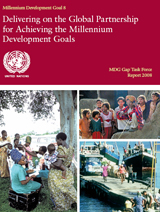
Delivering on the Global
Partnership for Achieving the
Millennium Development
Goals - MDG Gap Task
Force Report 2008
Important gaps remain in delivering on the global commitments in the areas of aid, trade, debt relief, and access to new technologies and to affordable essential drugs and treatment for HIV, malaria and tuberculosis. A new report by the United Nations Millennium Development Goals Gap Task Force identifies these gaps in detail and provides recommendations to all major stakeholders on how to address these gaps. In the countdown to 2015, urgent responses are needed to bridge the existing implementation gaps to make good on the promises made to achieve the Millennium Development Goals.
Inadequate access to essential medicines for HIV, malaria and tuberculosis
The findings of the report show that in some developing countries strong partnership between government, pharmaceutical companies and civil society, including consumers can lead to improved access to affordable essential medicines for HIV, malaria and tuberculosis.
However, access to essential medicines in developing countries is far from adequate. Information available in a number of countries suggests the existence of large gaps in the availability of medicines in both the public and private sectors as well as a wide variation in prices which render essential medicines unaffordable to poor people.
Millennium Development Goals Gap Task Force
The report was launched by the UN Secretary General Ban Ki-moon on 4 September. The Task Force was created by the Secretary-General following discussion of the Policy Committee on 1 May 2007 to improve monitoring of the global commitments contained in the Millennium Development Goals.
The main purpose of the Millennium Development Goals Gap Task Force is to systematically track existing international commitments and their fulfillment at the international and country level in the areas of official development assistance, market access, debt relief, access to essential medicines and technology.
The Task Force integrates more than 20 UN agencies, including participation from UNAIDS, the World Bank and the IMF, as well as the OECD and WTO. The United Nations Development Programme and the Department of Economic and Social Affairs of the United Nations Secretariat (UN/DESA) are lead agencies in coordinating the work of the Task Force.
Gaps remain in delivering on global commitments
Press centre:
Launching report by MDG Gap Task Force, Secretary-General underscores need for quantitative, qualitative shift in efforts to halve extreme poverty (4 September 2008)
External links:
Publications:

Feature Story
Belgium renews support to UNAIDS
09 September 2008
09 September 2008 09 September 2008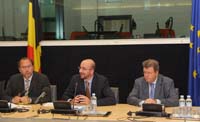
(from left): Dr Piot together with the Belgian Minister for Development Cooperation Charles Michel and the Director-General Peter Moors speak with journalists at a press conference in Brussels.
Credit: Directorate-General for Development Cooperation
UNAIDS Executive Director Dr Peter Piot and the Belgian Development Cooperation Minister Charles Michel met in Brussels on 9 September to announce Belgium’s new four year funding agreement to UNAIDS.
This latest multiyear accord covers the period 2008-2011 and provides financial support to UNAIDS’ Unified Budget and Workplan; Belgium’s previous agreement covered the years 2004-2007.
During the meeting, Dr Piot provided Minister Michel and his advisers with an overview of the global AIDS epidemic and outlined the activities of UNAIDS and its partners in responding to HIV. Dr Piot emphasized the recent successes in providing antiretroviral treatment to three million people in low- and middle-income countries and of efforts to strengthen prevention initiatives.
Belgium renews support to UNAIDS
External links:
Related

Feature Story
Disability and HIV in Jamaica
08 September 2008
08 September 2008 08 September 2008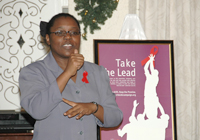
The programme ensures that public health information on television has the necessary sign language for the deaf community.
To address the inclusion of the persons with disabilities in HIV-related public education the “Education and economic empowerment for persons with disabilities: Responding to HIV” programme is being implemented by the Jamaica Council of Persons with Disabilities (JCPD) in the Ministry of Labour and Social services and is financially and technically supported by UNAIDS Jamaica.
“Individuals with disability are often overlooked in HIV prevention and AIDS outreach efforts,” said Miriam Maluwa, UNAIDS Country Coordinator for Jamaica, The Bahamas and Belize. “To ensure their inclusion in HIV-related public education, this innovative information and economic empowerment programme is being implemented as part of the national response to HIV.”
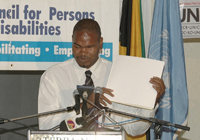
The programme provides HIV prevention information in Braille for blind and visually impaired individuals
Using a creative approach, the programme directly addresses the disabled community on the subject of HIV, customizing messages and information and delivering it in accessible formats to suit their disabilities such as providing information in Braille for blind and visually impaired individuals; texting HIV prevention messages and ensuring that public health information on television has the necessary sign language for the deaf community.
The programme is coupled with an income generation component to assist people in accessing business skills and small grants to initiate and manage their own business, thus reducing their vulnerability to HIV.
Empowering deaf women and girls
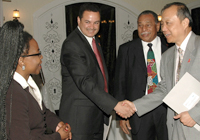
On the occasion of the launch of the HIV-related public education programme for people with disabilities the Jamaica Minister of Labour and Social Services Andrew Galimore (second from left) greets Chinese Ambassador to Jamaica Chen Jinghua. Miriam Maluwa, UNAIDS Country Coordinator for Jamaica, The Bahamas and Belize and the Panamanian Ambassador to Jamaica look on.
The programme is a scale-up of a very successful island-wide project carried out in 2006 which educated deaf women and girls, and their service providers, about HIV and on the wider issue of gender relations.
This project came about in response to results of a needs assessment survey which showed that deaf women experience gender-based violence at a disproportionate rate, particularly violence of a sexual nature including rape, battery, incest and sexual abuse. These unsolicited sexual encounters place deaf women at significantly greater risk of contracting HIV and other sexually transmitted infections.
Within the project women were empowered with self-defense and alternative economic skills to strengthen their economic independence.
The above programmes complement efforts of UNICEF and UNFPA Jamaica who are specifically addressing matters of children with disabilities and HIV and sexual reproductive rights of persons with disabilities, respectively.
Background
The disabled community constitutes one of the most vulnerable groups within Jamaica. Statistics are show that of the approximately 200,000 persons living with a disability in the country, less than 1% of this community is in paid employment.

Participants at the launch of the programme
Through a ripple-on effect, the education and economic empowerment for persons with disabilities programme should positively impact the lives of many, preventing HIV through reducing people vulnerabilities by empowering them with knowledge and economically, equipping them with a means of generating their own income.
Disability and HIV in Jamaica
Feature stories:
Making a difference: UNAIDS in Jamaica (14 March 2008)
Publications:
Global Survey on HIV/AIDS and Disability - Yale University, World Bank

Feature Story
Challenges to universal access in low prevalence countries in Asia Pacific
03 September 2008
03 September 2008 03 September 2008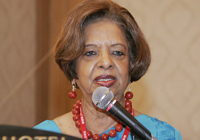
Dr Nafis Sadik, UN Secretary General
Special Envoy on AIDS in Asia and the Pacific delivered the closing address to the 2nd Regional Consultative Meeting.
Credit: UNAIDS
In countries with low HIV prevalence, that is, with less than 1% of the population reported to be living with HIV, there are specific challenges to an effective AIDS response. In order to assess these issues in the Asia Pacific region, the second regional consultative meeting on universal access to HIV prevention, treatment, care and support took place in Manila 26-28 August 2008.
Challenges for low prevalence countries
When a minority of the population is affected by HIV, a lower prioritization may be given to AIDS programmes alongside other competing development priorities. In addition, the epidemic can remain relatively “invisible” in a society where the main modes of HIV transmission are related to behaviours of unprotected paid sex, use of contaminated needles and syringes by people who inject drugs, and unprotected sex between men.
"Know your local epidemic"
Given these challenges, experts argue the importance for a country to understand what is specifically driving its epidemic and spends resources in a focussed way. So "knowing your local epidemic" and choosing the right combination of interventions would result in a more cost-effective and successful response.
Bringing services to where most needed

(From left) Dr. Mario Villaverde,
Undersecretary Department of Health,
Republic of the Philippines; Mr. Rico
Gustav, APN+; Hon. Lyonpo Zangley
Dukpa, Minister of Health, The
Kingdom of Bhutan; Mr. Andric Nelson,
Associate Executive Director, Ceballos,
KPGG; Hon. Nimal Siripala de Silva,
Minister of Healthcare Nutrition, Sri
Lanka; Dr. Purnima Mane, Deputy
Executive Director, United Nations
Population Fund (UNFPA); Hon.
Ratu Epeli Nailatikau, Interim Minister
of Foreign Affairs, Fiji participated in a
closing press conference. Credit: UNAIDS
The report of the independent Commission on AIDS in Asia published earlier this year found that it is vital that national responses are evidence-based and bring services to where it is most needed. However an additional challenge for low-prevalence countries is to reach these people whose behaviour may marginalize them from mainstream society– these include men who have sex with men, people who inject drugs, sex workers and their clients.
Asia and the Pacific
Despite a few notable successes in containing the epidemic, infections continue to rise throughout the Asia Pacific region and infections have reached concentrated levels in a number of countries, which were previously termed as low prevalence. Low prevalence is not a cause for celebration, rather consistent with Millennium Development Goal 6; the call to action needs to be from low to zero prevalence.
Second regional consultative meeting on universal access to HIV prevention, treatment, care and support
In order to assess these complex issues in the Asia Pacific region, the second regional consultative meeting on universal access to HIV prevention, treatment, care and support took place in Manila 26-28 August 2008.
The three day meeting was hosted by the Department of Health, Republic of the Philippines and co-organized with support from UNAIDS and its Cosponsors. More than 100 delegates including health ministers, interim foreign affairs minister and experts from national governments, civil society and international agencies participated. The UN Secretary General’s Special Envoy on AIDS in Asia and Pacific Dr Nafis Sadik also attended, as did Dr Purnima Mane, Deputy Executive Director United Nations Population Fund (UNFPA) and Mr Prasada Rao, UNAIDS Asia-Pacific Regional Director.
The meeting reviewed the findings and recommendations of the Commission on AIDS in Asia, which included among others that Heads of Governments of Asian countries should assume stronger leadership role in national AIDS responses. It concluded with the adoption of the Manila 2008 Statement of Cooperation in which low prevalence countries in Asia and the Pacific commit to mobilizing the resources required to meet universal access targets, to scaling-up effective strategies informed by the evidence of the nature of the epidemics in these countries, and to designing context-specific programmes.
Challenges to universal access in low prevalence
Feature stories:
Independent Commission on AIDS in Asia calls for countries to craft new responses (26 March 2008)
Asia Pacific: Call for action on AIDS (1 November 2006)
External links:
Publications:
Manila 2008 Statement of Cooperation, 28 August 2008, Manila Philippines


